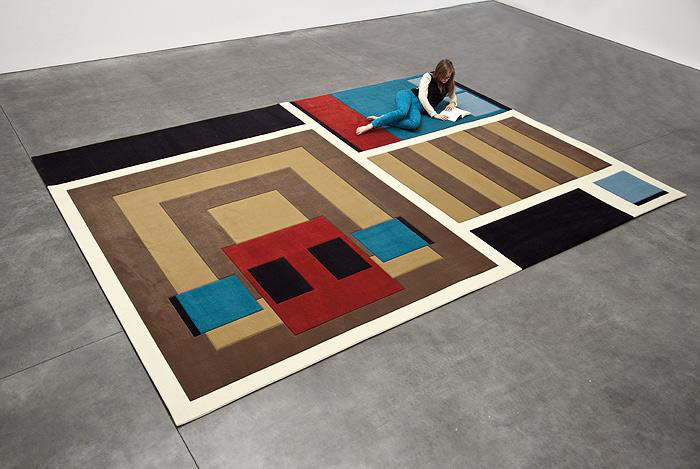Nathalie Du Pasquier’s retrospective, at the Institute of Contemporary Art, unfolds like a lesson in how things go (or sometimes don’t go) together. A redux of Du Pasquier’s 2016 exhibition at Kunsthalle Wien in Vienna, the ICA’s upstairs galleries are expertly transformed into a dizzying display of paintings, painted walls (as in interior decorating), furniture, sculpture, drawing, custom wallpaper, installation, and carpets.
It is important to mention that the exhibition, as designed by Du Pasquier, “is structured like a city, with each room functioning like a building and focused on a different aspect of her thinking and creative process,” according to the show text. Although the analogy between “rooms as buildings” as “creative process”, is not apparent without prompting the viewer to see it, the compartmentalizing and sequencing of work is pronounced and extremely useful when faced with the breadth of work in the exhibit.
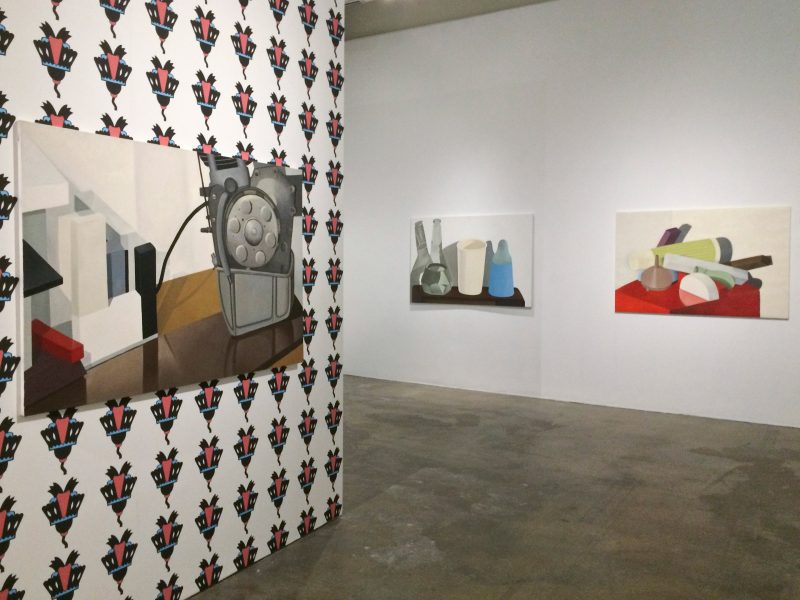
A backwards walk through the show and the role of still life paintings
It was not premeditated that I first entered the exhibit from the back entrance, accidentally skipping the curator’s wall text and exhibition brochures. While ascending the ICA ramp into the show, I stop at the switchback and notice six abstract geometric icons mounted high on the wall. I mentally catalog the images–that remind me of geometric hieroglyphs–and move on, emerging in a gallery filled with large and brightly painted still life oil paintings.
The still life paintings turn out to be a good place to start, remaining an important constant throughout the show. From representational to abstract, objects in paintings slip and slide around on an unpredictable perspective grid, in which recognizable images (a funnel, fruit, vase) become geometric shapes that morph into abstract futuristic landscapes, which finally boil down into shape-forms and color relationships that are less of a depiction than deconstruction of an image.
Continuing on, I encounter multiple rooms and spaces painted in a unifying color or pattern. For instance, one room is a pink bismuth color (a color used copiously throughout the exhibit), populated by small isometric architectural drawings; another room is robin’s egg blue, occupied by small still life paintings, portraits of both objects and people, and small sculptures all perched on a pair of narrow shelves that circumnavigate the space.
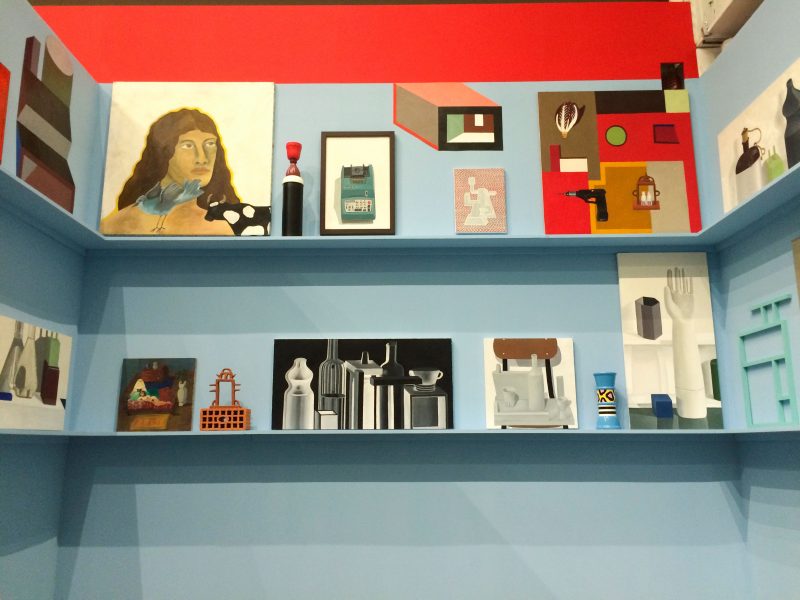
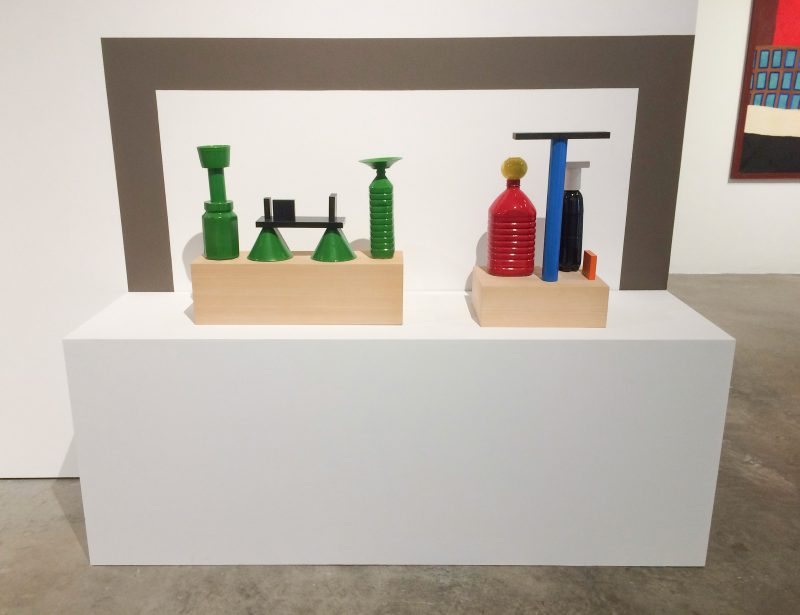
The origin of the show’s title, “Big Objects Not Always Silent”
Yet another room, a small alcove in battleship gray, contains an installation with sound. Three human-scale geometric shapes protrude from the wall in low relief, with recorded sound emanating from the central object. The sound is Du Pasquier tinkering in her studio, layered with the voice of her collaborator, musician and poet Steve Piccolo, reading a list of nonsensical word combinations that register somewhere in-between surrealistic and deadpan humorous. The work is ironically monotone and monochrome, and is described by Du Pasquier as the catalyst for the title of the show, Big Objects Not Always Silent.
At this point the organization of things starts coming into focus. Not the conceptual part, per-se, but the functional wayfinding and an understanding of how the individual works relate to the larger whole. Remembering the geometric hieroglyphs from the ramp, it is those basic images that I find imbedded in many of the works throughout the exhibit in different iterations and combinations. These geometric forms become a key to a theoretical map and syntax of Du Pasquier’s larger body of work.
Du Pasquier and other artists working with functional or faux functional design
As a founding member of the postmodern Italian design group Memphis, producing furniture and other utilitarian objects from 1981-86, and then primarily as a painter from 1987 until the present, Du Pasquier’s aesthetics favor unpredictable combinations of patterns and color that exemplify her artistic interests that range from the graphic boldness of African textiles to the designs of Wiener Werkstätte, and the Arts and Crafts movement. Conversely, (and I say this because Arts and Crafts is the flip side of utilitarian) her utilitarian-inspired iconography and architectural precision links to contemporary art that also occupies the intersection of art and design, with unexpected parallels between Haim Steinbach’s poetic still life combinations of found objects; Andrea Zittel’s carpet furniture; and Roy McMakin and Allan Wexler’s conceptual and sculptural subversions of furniture design and architecture.
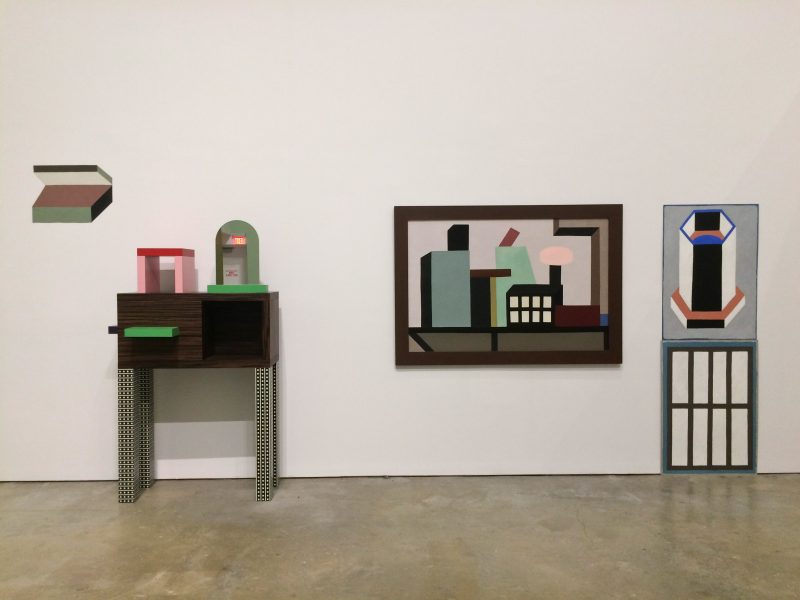
The show as the artist’s “creative headspace”
Big Objects Not Always Silent is ultimately “an installation comprised of an exhibit” that takes itself apart and puts itself back together through the interpolation of design, architecture, painting, sculpture, shape, scale, color, pattern, image; and through still life painting a clear interest emerges in exploring formal ways of seeing. Du Pasquier is didactic (this is not meant as derogatory. She is teaching us her idiosyncratic way of seeing things) in the refreshingly playful and unexpected way she pairs objects, images, patterns and colors together. Whether serving up a plate of tools for lunch in a still life painting, or obsessively rendering a brick as a sculpture, she disarms with her wit and experimentation. In the way Steinbach pairs a Yoda masks with a boom box, or that Zittel’s playful utopianism suggests that a carpet can be a guide for furniture placement, Du Pasquier also plays within a complex aesthetic and conceptual arena of how things go together with a self taught unpredictability that has her carpets hanging high on a wall while also under foot, muddying the boundary between a painting and the wall it is on, and conceptualizing an entire exhibit as her creative headspace, which I am very glad to have experienced.
Nathalie Du Pasquier, “Big Objects Not Always Silent” at the Institute of Contemporary Art, icaphila.org/ September 13 – December 23, 2017 Check website for days and hours.
For further reading:
Nathalie Du Pasquier
Memphis design group
Haim Steinbach
Andrea Zittel
Roy McMakin
Allan Wexler
